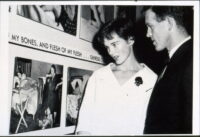
Image: David Moore at Family of Man in Sydney, 1959
Essay—All Too Human: Photography Exhibitions in Australia
26.4.22
Daniel Palmer explores the history of photography exhibitions and the shifting societal attitudes to how we document and discuss humanity.
Photographic images mediate our experience of the world as never before. They fuel our imaginations and scaffold our memories, arriving in endless streams and grids on our mobile screens. Thanks to photo-centric social media platforms, the mobile phone has rapidly become an extraordinary epicentre for the creation, sharing and viewing of every imaginable form of photography, from the banal to the bizarre, the ephemeral to the memorable. And importantly, from the perspective of the PHOTO 2022 International Festival of Photography, the mobile phone also now mediates our experience of exhibitions in galleries and museums, which in the late twentieth century became critical spaces where photographs could be experienced for their aesthetic, social and historical values, beyond immediate functional uses.
Historically, photography exhibitions in Australia have helped to situate and shape our sense of ourselves and our place in the world. Think of the centrality of photography within nineteenth century colonial exhibitions, or the belated invention of the myth-making Sunbaker (1938), first shown in Max Dupain’s retrospective at the Australian Centre for Photography in 1975. Exhibitions – as the once interchangeable term ‘exposition’ reminds us – expose something to public view, which spectators negotiate based on their embodied encounters. Most are quickly forgotten, and their themes and physical forms of display inevitably reflect the time and place they were made. However, ambitious exhibitions can epitomise an epoch and influence the direction of things to come.
PHOTO 2022 presents the broadest possible platform for photography through displays of photography in galleries and public spaces across Melbourne and beyond, enabling a diverse range of encounters. And it also includes a comprehensive online representation, for audiences who can’t visit in person. This year, commissions and aggregations of exhibitions have been brought together under the theme ‘Being Human’, and in this essay I want to explore some aspects of the history of photography exhibitions in Australia that might provide a context for this colossal notion.[1]
It is difficult to think of any photography exhibitions in Australia that even approached ‘humanity’ in general before the late 1930s. Australian photography exhibitions in the nineteenth century focused on legitimating colonial development, while camera artists in the early twentieth century such as Harold Cazneaux, John Kauffmann, Ruth Hollick and Max Dupain staged exhibitions of landscapes, portraits and abstracts for circles of photography enthusiasts. The broader notion of human life as a topic for a photography exhibition only emerged with the first exhibitions of documentary photography at the start of World War II, influenced by modern work from the interwar period in Europe and social documentary practice from the US in the 1930s. Dahl and Geoffrey Collings, for instance, mounted their Exhibition of Modern Industrial Art and Documentary Photography at the David Jones Galleries in Sydney in 1939 with the claim: ‘We are dealing with life’. In Perth, Axel Poignant and Hal Missingham presented a similarly modern spirit in an exhibition at Perth’s Newspaper House in 1941. They sought an honest understanding of humanity through a simple and direct approach in contrast to the lingering painterly influence of Pictorialism then dominating annual Salon exhibitions. As they wrote, ‘the camera user should develop his [sic] power of vision’ as a witness to human life.
This humanistic approach to photography culminated when The Family of Man exhibition toured from the Museum of Modern Art in New York to Australia in 1959. Organised by director of photography Edward Steichen in 1955, the blockbuster exhibition comprised over five hundred black and white documentary photographs taken in sixty-eight countries, and among the 273 photographers were two Australians: David Moore and Laurence Le Guay. Viewed by millions of spectators, by 1959 The Family of Man was halfway through its comprehensive international tour organised by the US Information Agency, in the context of Cold War cultural diplomacy, during which five copies of the exhibition panels travelled to thirty-eight countries including the Soviet Union.[2] Aside from the comforting metaphor of the human family, the exhibition’s popularity owed to its bold and innovative mode of displaying documentary photographs, in which enlarged, unframed prints of various sizes were presented magazine-style on panels organised across thematic sections – such as love, play, work and death – which incorporated quotes from religious texts and the United Nations’ 1948 Universal Declaration of Human Rights.
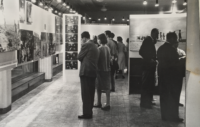
Image: Family of Man in Melbourne, 1959
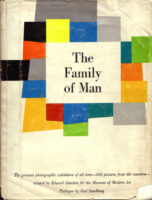
Image: Cover of Family of Man Book, 1955
The Family of Man opened in Melbourne in February 1959 at the Preston Motors Showroom on Russell Street, in an elegant art deco building (since demolished). As a result, photographs of war, famine and childbirth were displayed among another great American export: shiny motorcars. According to newspaper reports, daily crowds of more than three thousand attendees thronged to visit over its four-week run, even with an admission charge. In Sydney, the exhibition was shown over an entire floor of the David Jones department store, where a newspaper photographer captured a young David Moore and his wife looking at his own photograph, Redfern interior, 1949 – a flash-lit image of a young mother and child in a squalid Australian bedroom.
The Family of Man remains unique among photography exhibitions for the number of critical and celebratory essays and books devoted to Steichen’s vision that photography could offer a ‘mirror of the essential oneness of mankind throughout the world’.[3] Influential denunciations – notably Roland Barthes’ acerbic 1956 critique of The Family of Man as a product of ‘classic humanism’, in which he attacked its sentimental veneer of universality and its suppression of ‘the determining weight of History’ – only enhanced its influence.[4] In recent years, that critique has itself come under review, notably by Ariella Aïsha Azoulay who claims that Barthes misses the ‘civil potential of photography’ whereby ‘[t]he fragility of the human condition is enfolded in each and every photograph’.[5] By focusing on the photographed subjects rather than the curator, Azoulay displaces the conventional criticism that the exhibition presented a Western perspective (of the 273 photographers, 233 were European or American) and a largely male point of view (only 40 female photographers were included, and that was seen as an impressive achievement).[6]
The Family of Man’s model of ‘global citizenship’[7] and its advocacy for human rights was clearly at odds with Australia’s White Australia Policy, already under challenge by post-war immigration.[8] Indigenous Australians would have to wait eight more years even to be formally counted as fully-fledged citizens in the 1967 referendum. And The Family of Man clearly had a lasting influence on Australian photographers who saw it, cementing a model of humanistic documentary photography that was to dominate 1960s practice, in which photography was understood as a universal language able to communicate simply and directly across barriers of race and culture.
Fired up by The Family of Man, the collective of earnest Melbourne-based amateur photographers Group M held the first of a series of annual exhibitions titled Photovision at the local Museum of Modern Art – in a cobblestone lane off Flinders Street – less than two months later in 1959.[9] Advocating the use of ‘straight’ photography as a means of expression, Group M presented its most ambitious exhibition, Urban Woman, at the Lower Melbourne Town Hall in 1963. Immodestly billed as ‘the most ambitious exhibition ever to be attempted by a group of Australian photographers’, it comprised more than two hundred mostly candid photographs by thirteen photographers.[10] The theme was conceived as a direct response to The Family of Man – inspired by an observation of the frustrations and loneliness of young mothers in the suburbs – and its exhibition design followed suit, featuring enlarged unframed prints, some measuring up to 150 x 100 centimetres and a central wooden structure to display suspended enlargements. With a stated aim ‘to confront reality with an unprejudiced eye’,[11] the only attempt at narrative was their arrangement from youth to old age, which had also been one of the thematic threads of The Family of Man. Urban Woman attracted significant coverage in the press, who celebrated the exhibition as a ‘a commentary on the life of women in a modern city’ and noted that no telephoto or flash was used.[12] Remarkably, the fact that an exhibition of photographs about women were entirely taken by men seems to have gone unnoticed.
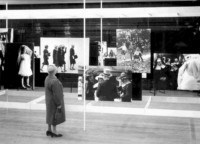
Image: Large scale photographic prints on display for the Urban Women exhibition at Melbourne Town Hall, 1963 (NLA)
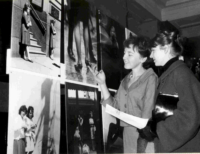
Image: Two women inspect photographs on display as part of the Urban Women exhibition at Melbourne Town Hall, 1963 (NLA)
In 1965, Group M mounted their final and most critically acclaimed Photovision exhibition, A Time to Love. For this exhibition, four core members – George Bell, Albert Brown, John Crook and Roy McDonald – presented a series of photographs on a different subject, ranging from aged care and mental health to the aftermath of bushfire and Indigenous communities at Lake Tyers. In the catalogue the photographers made the rather contemporary case that ‘these photographs are not the product of inspiration, but lengthy negotiation, observation and patience born of responsibility to the subjects portrayed’.[13] A reviewer in the Bulletin supported this pedagogical purpose: ‘We need much more of photography of this kind and calibre. It should be more widely commissioned, both for the archives and for the education of the community’.[14] But nothing further eventuated. Instead, in the 1970s a new generation of photographers immersed in counter-culture politics brought a new range of personal subject matter to the fore. Australian tertiary educational institutions had started to introduce art photography programs, and photography’s position was boosted by institutional funding from the Whitlam Labor government (1972–75). The Australian Centre for Photography in Sydney opened in 1974, photographers and enterprising independent gallerists embraced the opportunity to exhibit photographs of a personal and experimental nature, and a small ‘photo-boom’ occurred.
Perhaps most importantly, a wave of feminist photographers emerged in the 1970s. The fresh approach of figures like Sue Ford, Carol Jerrems, Ponch Hawkes, Micky Allan and Ruth Maddison made conventional social documentary approaches look decidedly paternalistic if not patriarchal. Their work fed into the more conceptual thinking of postmodern artists such as Julie Rrap, Pat Brassington and Tracey Moffatt in the 1980s and 1990s, in which photography was central but documentary was nowhere to be seen. In the context of the critique of representation, the tenets of documentary photography came to seem naïve at best. The intermittent return of humanistic documentary to galleries in the past two decades, in a more plural environment, has been highly selective: Indigenous photographers such as Ricky Maynard documenting his Country and Elders, while Australia’s only Magnum photographer Trent Parke has adopted a theatrical approach to his exhibitions, such as Minutes to Midnight (2005) to offer a personal vision of Australia on the brink of social and ecological catastrophe through dark, expressive documentary images.
Six decades after The Family of Man, the National Gallery of Victoria hosted the travelling exhibition called Civilization: The Way We Live Now (2019). Curated from Europe by William A. Ewing and Holly Roussell, but including photographers from Africa and Asia, the exhibition sought a broad audience to illustrate what it called ‘this increasingly globalised world’.[15] The ‘we’ in the title pointed to a planetary civilization, a theme of ‘homogenised humanity’, as one enthusiastic reviewer observed, noting that where ‘The Family of Man posed the question what do humans have in common to make them human, photographs in Civilization focus on what the curators term the “shared human experience”’.[16] But it was a curious conceit for an exhibition whose sublime, monumental framed colour images effectively mirrored the neo-liberalism globalisation it sought to portray – the bizarre built environment and mass behaviour of contemporary capitalism – and the overall aesthetic was itself homogenous. The local curators did their best to counter the cold global spectacle, to make it more relevant to audiences, through the addition of more modest work by Australian photographers.
In 2022, a time when it feels difficult to have confidence in humanity in general, the theme of ‘Being Human’ seems purposely bold. But despite the invitation to explore ‘what unites us, and what makes us unique as individuals’ artistic director Elias Redstone and his team are clearly more interested in the politics of identity and the notion of ‘different lived experiences’ – what they term ‘the contemporary human condition’ – than a simple celebration of human experience.[17]Characteristically, the opening photo in the PHOTO 2022 Festival Guide is a portrait of a defiant young Chinese person with dyed blond hair staring straight into the camera, taken by young Chinese photographer Luo Yang. In all their multiplicity, the photographs in ‘Being Human’ offer a future-oriented portrait of human life, notably through the diversity of the artists. The majority of artists in ‘Being Human’ – over two-thirds – are female identifying. First Nations and other non-Western voices and perspectives are privileged, along with ‘queer stories’ (indeed both queerness and Blackness are important to several key artists like Paul Mpagi Sepuya and Christian Thompson). The exhibitions foreground, in short, the experiences of those who are historically others in the history of photography. And for the most part their photographs are not of distant strangers, as in so much photojournalism, but intimate explorations of their own communities. The images reveal a clear level of trust between the photographer and their subjects in what are largely staged representations of real people.
Portraiture overwhelmingly dominates the exhibitions in ‘Being Human’. Portraits of marginalised people here serve as a clear-sighted and poetic visual activism (for instance the work of Poulomi Basu, Mohamed Bourouissa and Hoda Afshar). Some artists adopt the techniques of fashion photography, but again this is largely to offer a counterpoint to Western ideals of beautiful bodies (such as Atong Atem), or, for instance, to raise questions around perceptions of aging (notably Gillian Wearing and Ponch Hawkes). An emphasis on the performative body helps make sense of the inclusion of PHOTO 2022’s new ‘Icons’ programming which features an epic blow up of a single Cindy Sherman Untitled Film Still and a survey exhibition by German-Australian fashion photographer Helmut Newton – whose phantasmatic imagery of empowered models must also now be read in terms of whiteness.[18] And the fact that portraiture dominates PHOTO 2022 reminds us that that while the notion of photography as a universal language was popularised by The Family of Man, it was the German portrait photographer August Sander who in 1931 first spoke of photography as a ‘universal language’, unlimited by language barriers, soon after the publication of his Antlitz der Zeit (Face of Our Time) in 1929, as part of his life’s work to document German social classes and occupations.[19] Sander had a vision for photography to provide a ‘total vision of the people on earth’ which he felt would provide better understanding of humanity.[20] Today, technology has enabled precisely this potential – think of Facebook and Instagram – and yet the benefits are controlled by global corporations. So many of the photographs served up to us on our mobile phones simply commodify our existing social worlds and human understanding remains blinded by the all too human impulse to fear difference. Given our common destiny on this warming planet, the embrace of global citizenship at the heart of ‘Being Human’ has never seemed more necessary.
Daniel Palmer is Associate Dean of Research and Innovation in the School of Art at RMIT University. His books include Photography and Collaboration: From Conceptual Art to Crowdsourcing (Bloomsbury 2017) and Installation View: Photography exhibitions in Australia 1848–2020 (Perimeter Editions 2021), co-authored with Martyn Jolly.
[1] This essay draws on my research with Martyn Jolly published as the book Installation View: Photography Exhibitions in Australia (1848-2020), Melbourne: Perimeter Editions, 2021.
[2] There were minor variations in the touring copies of the exhibition. For instance, the single colour image in the New York exhibition – a large, backlit transparency in a darkened room depicting the explosion of a hydrogen bomb – was changed to black and white. The entire exhibition is now on permanent display at the Château de Clervaux in Luxembourg and listed on the UNESCO Memory of the World Register.
[3] Edward Steichen, ‘Introduction’, The Family of Man exhibition catalogue, Museum of Modern Art, New York, 1955, 4.
[4] Roland Barthes, ‘The Great Family of Man’, Mythologies, trans. Annette Lavers, London: Granada, 1982, 13
[5] Ariella Azoulay, ‘The Family of Man: A Visual Universal Declaration of Human Rights’ in Thomas Keenan and Tirdad Zolghadr, eds., The Human Snapshot, Berlin: Sternberg Press, 2013, 30, 42. Contra Barthes, who reads the photographs as ‘descriptive statements with universal claims’, Azoulay reads them ‘as prescriptive statements claiming universal rights.’ (20)
[6] See, for instance, Eric J. Sandeen, Picturing an Exhibition: The Family of Man and 1950s America, University of New Mexico Press, Albuquerque, 1995; and Gerd Hurm, Anke Reitz, Shamoon Zamir, eds., The Family of Man Revisited: Photography in a Global Age, London, I.B. Tauris, 2018.
[7] Alexandra Moschovi. A Gust of Photo-Philia: Photography in the Art Museum, Leuven University Press, 2021.
[8] Anna Haebich, Spinning the Dream: Assimilation in Australia 1950–1970, Fremantle Press, 2008, 24.
[9] George Bell, Albert Brown and John Crook, ‘The Dark is Light Enough – A concise history of Group M’, April 1994, artist file, held in the State Library of Victoria, Group M: Australian Gallery File, Australian Art and Artists Files Collection.
[10] Bill Hannan essay in Group M, Urban Woman, exhibition catalogue, Melbourne, 1963, n.p. The exhibition subsequently toured to Geelong, Launceston, Perth and even the Australian Embassy in Mexico.
[11] Group M, Urban Woman, exhibition catalogue, Melbourne, 1963. Quoted in Susan van Wyk, ‘Something’s Happening Here… Aspects of Australian Documentary Photography in the 1960s’, in Jennifer Phipps (ed.)., I Had a Dream: Australian Art in the 1960s, Melbourne: National Gallery of Victoria, 1997, 80.
[12] Patricia Pugh, ‘Urban Woman’, The Sun, Sydney, 21 August 1963, p. 33.
[13] Photovision ’65 A Time to Love exhibition catalogue, 1965, published by the Museum of Modern Art and Design of Australia, in the collection of the State Library of Victoria, Melbourne.
[14] Bill Hannan, ‘Photography without preaching’, Bulletin, Sydney, 23 October 1965, 46. Brown later sent copies to the University of Texas, which accepted the photographs for its Gernsheim Collection. After Group M wound down later that year, Brown continued to push his case for ‘purposeful photography’ and was appointed as an honorary photographic consultant to the NGV.
[15] https://www.ngv.vic.gov.au/exhibition/civilization
[16] Sasha Grishin, ‘Civilization: The Way We Live Now – powerful, troubling photographs of a crowded planet and uncertain future’, The Conversation, 17 September, 2019, https://theconversation.com/civilization-the-way-we-live-now-power…bling-photographs-of-a-crowded-planet-and-uncertain-future-123593
[17] PHOTO 2022 Festival Guide, 3.
[18] British photographer and critic Daniel C. Blight has recently argued that the canonical history of photography is best understood as a history of white visuality, and the camera as the extension of the white eye. See Daniel C. Blight (ed.), The Image of Whiteness: Contemporary Photography and Racialization, London: SPBH Editions, 2019.
[19] Sander used the expression in a lecture given on German radio, translated by Anne Halley in 1978. August Sander, ‘Lecture 5: Photography as a Universal Language 1931’, The Massachusetts Review 19 (4), 1978: 674–679. Sander declares that his photographic work ‘Human Beings of the Twentieth Century’ (from which a selection Face of Our Time appeared in 1929) is “basically a declaration of faith in photography as universal language” (676).
[20] Sander, ‘Lecture 5’, 679.